
Glimpses
into the past, present, and future of solo dance
- Ketu Katrak
e-mail: khkatrak@uci.edu
Photos: Miles
Brokenshire June 20, 2010 A provocative
title 'Solo Dance' catches our imagination during an excellent Symposium
(June 4-5, 2010) exploring "Perspectives from South India and Beyond",
presented in Toronto, Canada, by InDance in collaboration with the Royal
Ontario Museum and Friends of South Asia. The gathering included dancers,
choreographers, and scholars from India, North America, and Europe. This
event, distinctive in its careful curatorial organization, was a realization
of the vision of Hari Krishnan, Artistic Director of InDance and Davesh
Soneji, scholar of South Indian history, both deeply knowledgeable about
solo dance from South India, "particularly in its manifestation" notes
Krishnan in the Symposium booklet, "as Bharatanatyam [that has] emerged
as a global signifier of South Asian culture." The Symposium was delightfully
balanced between performances of present day Bharatanatyam and Contemporary
Indian dance, and scholarly papers traversing the history of devadasi
dance in the 19th and 20th centuries including its transformation by nationalist
and Brahmin influences. Dancers from India and North America appropriately
had the last word in a closing Plenary where they shared their processes
of creative choreography, and discussed challenges and rewards of doing
solo work in the late 20th and 21st centuries.
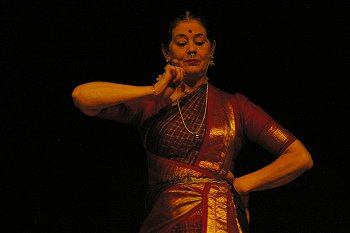 Saskia
Kersenboom
Saskia
Kersenboom
|
A profound sense
of reverence opened the Symposium with "the first songs (and ritual dances)
greeting the gods" in the temple, rendered expressively by Saskia Kersenboom,
who has studied the repertoire (for nearly twenty years) from P Ranganayaki,
dedicated to the Murugan temple in Tiruttani (Tamilnadu, South India) in
1931. Ms. Kersenboom conveyed a deeply devotional feeling with gentle lyrics,
taking the audience through the daily rituals punctuating different times
of the day until nightfall when she sang the gods to sleep with the sweet
lallis (lullabies). The tone was
set for the Symposium's showcasing of solo performing artists, and the
many-faceted discussions of hereditary devadasis as the original
custodians of music and dance. The Keynote by Professor Janet O'Shea, two
Special Sessions by noted musicologist scholar, BM Sundram, and dance critic
Sunil Kothari, three panels with nine speakers covered a rich terrain of
well-researched papers with accompanying visuals. O'Shea addressed
the complex terrain of solo dance usually associated with tradition, and
group/ensemble work with innovation or experimentation. She both investigated
and challenged these categories and examined competing aesthetics facing
solo dance in the 21st century. Dr. Sundaram recounted anecdotes of meeting
devadasis, including their resistance to unfair branding of their
profession and their efforts to fight the 1947 legislation banning their
practice. Although they did not succeed, Dr. Sundaram drew attention to
their "radical forms of resistance and artistic virtuosity." Kothari's
screening of Venkatalakshamma's abhinaya - a devadasi from
Karnataka, provided rare visual documentation of how solo dance "was preserved
and supported by the ruling elite of Mysore."
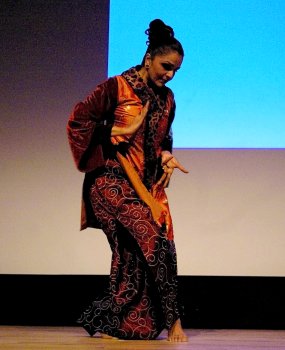 Anita
Ratnam
Anita
Ratnam
|
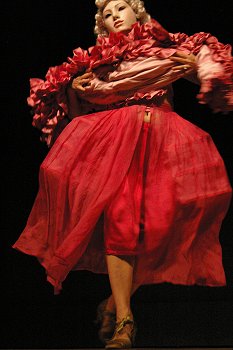 Patricia
Beaman
Patricia
Beaman
|
Solo dance performance
by Anita Ratnam in a spell-binding 15-minute version of her longer piece,
7 Graces that references the goddess Tara of Tibet, and evokes the
"feminine transcendental" was introduced by Krishnan as "non-linear, using
mythology as metaphor, even abstracting mythology and movement as maps
to navigate inroads into new movement and contemporary sensibility." A
neo-baroque solo by Patricia Beaman, Accumulating Venus uniquely
"deconstructed the Passacaglia de Venus (1725)" as noted in the program,
"juxtaposed with modern themes of celebrity, rejection, sensuality and
power." Leela Samson's talk, 'Reflections on my Journey' was interspersed
by a moving performance of her Bharatanatyam choreography including a dance
to a North Indian thumri.
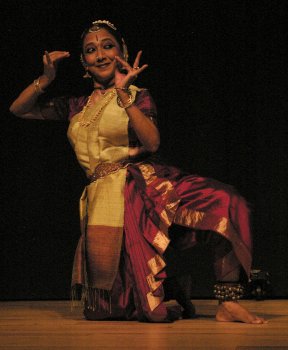 Leela
Samson
Leela
Samson
|
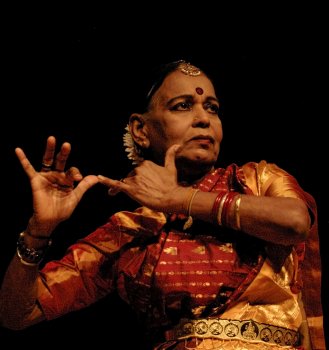 Shyamala
Shyamala
|
Other memorable
performances included a "Plenary dance performance of Padams and
Javalis: Solo dance as crafted by T Balasaraswati," rendered by
a senior disciple, Shyamala. Bala's unique abhinaya style where
the soloist moves with the talam even as she interprets the lyric
poetry was exquisitely brought to life via Shyamala's flowing abhinaya,
and ease of moving with the different talams. Another performance
highlight was InDance's presentation of "Nineteenth-century solo dance
repertoire in the twenty-first century," honoring the memory of devadasi
dance with live orchestra wherein scholar Soneji wore his nattuvanar
"hat" most ably. It was heartening to see Krishnan's rigorously trained
and expressive multiethnic dancers, present five solos from the devadasi
repertoire learnt by Krishnan from hereditary performers. Indeed, despite
legislation to eliminate devadasi dance, it has survived. An added
delight was to see Krishnan himself dance with Srividya Natarajan in an
energetic choreography of solo dance re-interpreted as a duet, a successful
"choreographic experiment pushing the form of the svarajati." Krishnan
introduced (with power-point) each dance item's technique, time-period,
and composer with keenly researched historical material.
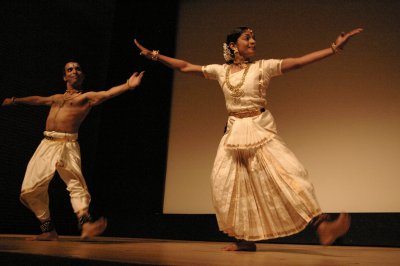 Srividya
Natarajan and Hari Krishnan
in Chakravakam
Svarajati
Srividya
Natarajan and Hari Krishnan
in Chakravakam
Svarajati
|
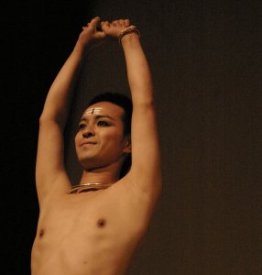 inDance's
Hiroshi Miyamoto
in Kaivara
Prabandham
inDance's
Hiroshi Miyamoto
in Kaivara
Prabandham
|
Among the nine
scholarly papers, a few made original contributions to dance scholarship
such as Joep Bor and Tiziana Leucci's fascinating discussion of "The European
performances of five devadasis in 1838 and 1839." Bor and Leucci
traced the devadasis' 18-month journey (with three musicians) from
a Vishnu temple in Pondicherry brought to France by impresario EC Tardivel.
As noted in the Symposium brochure, they were "billed as the 'real' Bayaderes
or Priestesses of Pondicherry" landing in Bordeaux on July 24, 1838, the
first devadasis to travel to Europe, dancing for the French royal
family at the Tuilleries and becoming "instant celebrities." Bor and Leucci's
extensive archival research into articles and newspaper reviews conveyed
positive ("they dance not only with the feet but the whole body") and negative
("they speak a language in their dance resembling that of the deaf and
dumb in gestures") impressions of the devadasis during the Orientalist
vogue in Paris of the 1830s, and their influence on major French ballerina
Marie Taglioni, even Anna Pavlova. Their impact continued even after they
left Europe.
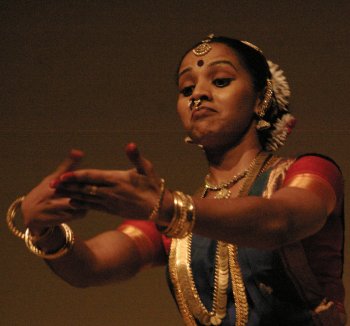 inDance's
Nalin Bisnath in Kuravanji
inDance's
Nalin Bisnath in Kuravanji
|
 inDance's
Shobana Raveendran in Salam Daru
inDance's
Shobana Raveendran in Salam Daru
|
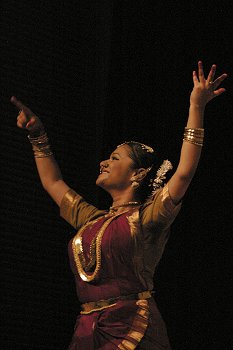 inDance's
Sreyashi Chakraborti in Modi
inDance's
Sreyashi Chakraborti in Modi
|
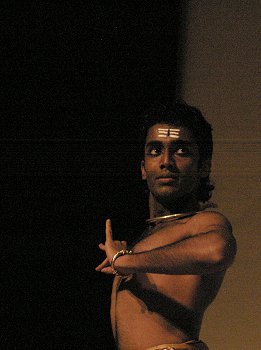 inDance's
Vinod Shankar in Jatisvaram
inDance's
Vinod Shankar in Jatisvaram
|
Davesh Soneji,
in "Salon to cinema: Telugu Javalis in colonial South India" discussed
the origins of the javali, as "a musical and literary form" in the
19th century Mysore court. Javalis in Telugu and Kannada languages
were "modern songs" as noted in the program, "modeled on the older Telugu
padam genre . . . performed by devadasi-courtesans during
salon performances patronized by elite Brahmins and landowning communities."
Soneji noted a fascinating historical detail - many javali composers
were in the colonial civil service as clerks or postal workers. Although
the javali's life was short, they were performed in early Telugu
cinema. Soneji made a useful scholarly intervention in using the words
"devadasi / courtesan" interchangeably, thereby asserting a sense
of solidarity among South and North Indian artistes who performed monumental
service in preserving the arts. Kersenboom added that not all devadasis
were dedicated to temples and that it is important to underline the prayoga
(environment, context) of the temples with many-faceted duties."Twentieth
century shifts in solo dance" panel included Teresa Hubel's useful historical
analysis about "the suppression (though not the destruction) of the matrilineal
culture of the dancing women of South India," its transformation into middle-class
notions of femininity that persist today even in the diapsora. Srividhya
Natarajan discussed "the social and psychic dimensions of the relationship
between the nattuvanar dance teacher" and a feminist student,
also noting caste and class hierarchies. Anne-Marie Gaston's "Living the
transformations in Bharatanatyam from 1964 to the present" shared research
on solo dancers moving from Chennai to Delhi in the 1970s where they encountered
the synergy of different Indian dance styles.
 Symposium
group
Symposium
group
|
The final panel,
"Reflections on Contemporary solo dance, identity, and selfhood" included
papers by Ketu Katrak analyzing the interplay of dance and theatre in the
work of Los Angeles based Post-Natyam Collective's artist Shyamala Moorty;
by Chitra Sundaram on South Asian dance in Britain having become "a spectacle."
Sundaram noted Shobana Jeyasingh's major contributions in contemporizing
Bharatanatyam that paved the way for Akram Khan's "paradigm-shifting" movement
work. Rathna Kumar delineated her dance journey for 35 years in Houston,
Texas and the increasing requests for group dance, short items, and Bollywood
style dance.Overall, the
Symposium was an exhilarating experience of two packed days with transcendent
moments of joy in witnessing performances and path-breaking intellectual
challenges of scholarly discourse and discussion. As a participant, I would
eagerly welcome a follow-up Symposium on the rich history of Indian solo
dance that enlightens our current performance practice and scholarship
in the 21st century.
Ketu H Katrak,
University of California, Irvine. |

